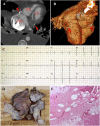Case report: Mechanical-electric feedback and atrial fibrillation-Revelation from the treatment of a rare atrial fibrillation caused by annular constrictive pericarditis
- PMID: 36760571
- PMCID: PMC9905231
- DOI: 10.3389/fcvm.2023.1100425
Case report: Mechanical-electric feedback and atrial fibrillation-Revelation from the treatment of a rare atrial fibrillation caused by annular constrictive pericarditis
Abstract
Atrial fibrillation (AF) is one of the most common arrhythmias encountered in clinical practice. The pathophysiological mechanisms responsible for its development are complex, vary amongst individuals, and associated with predisposing factors. Here, we report a case of AF caused by annular constrictive pericarditis (ACP), which is extremely rare due to its unusual anatomical form. In our patient, AF was refractory to multiple antiarrhythmic medications; however, spontaneous conversion to sinus rhythm occurred when the ring encircling the right and left ventricular (RV and LV) cavities along the atrioventricular (AV) groove was severed. This suggests that atrial stretch due to atrial enlargement and increased left atrial (LA) pressure may contribute to the initiation and maintenance of AF. This report highlights the importance of the careful investigation of rare predisposing factors for AF using non-invasive diagnostic approaches and mechanical-electric feedback (MEF) as a pathophysiological mechanism for AF initiation and maintenance.
Keywords: annular constrictive pericarditis; atrial fibrillation; atrioventricular groove; mechanical-electric feedback; predisposing factors.
Copyright © 2023 Yi, Li, Han, Qiu, Tao, Liu and Liu.
Conflict of interest statement
The authors declare that the research was conducted in the absence of any commercial or financial relationships that could be construed as a potential conflict of interest.
Figures



Similar articles
-
Association between left atrial phasic conduit function and early atrial fibrillation recurrence in patients undergoing electrical cardioversion.Clin Res Cardiol. 2018 Apr;107(4):329-337. doi: 10.1007/s00392-017-1188-9. Epub 2017 Nov 27. Clin Res Cardiol. 2018. PMID: 29181725 Free PMC article.
-
Functional Tricuspid Regurgitation Caused by Chronic Atrial Fibrillation: A Real-Time 3-Dimensional Transesophageal Echocardiography Study.Circ Cardiovasc Imaging. 2017 Jan;10(1):e004897. doi: 10.1161/CIRCIMAGING.116.004897. Circ Cardiovasc Imaging. 2017. PMID: 28073806
-
[A case of constrictive pericarditis with atrial fibrillation after mitral valve repair and Maze III procedure].Jpn J Thorac Cardiovasc Surg. 1998 Dec;46(12):1363-7. doi: 10.1007/BF03217931. Jpn J Thorac Cardiovasc Surg. 1998. PMID: 10037851 Japanese.
-
Pharmacological approaches in the treatment of atrial fibrillation.Curr Med Chem. 2004 Jan;11(1):13-28. doi: 10.2174/0929867043456241. Curr Med Chem. 2004. PMID: 14754423 Review.
-
[Epidemiology and therapy of atrial fibrillation].Ann Ital Med Int. 1996 Oct;11 Suppl 2:5S-10S. Ann Ital Med Int. 1996. PMID: 9004821 Review. Italian.
References
Publication types
LinkOut - more resources
Full Text Sources

